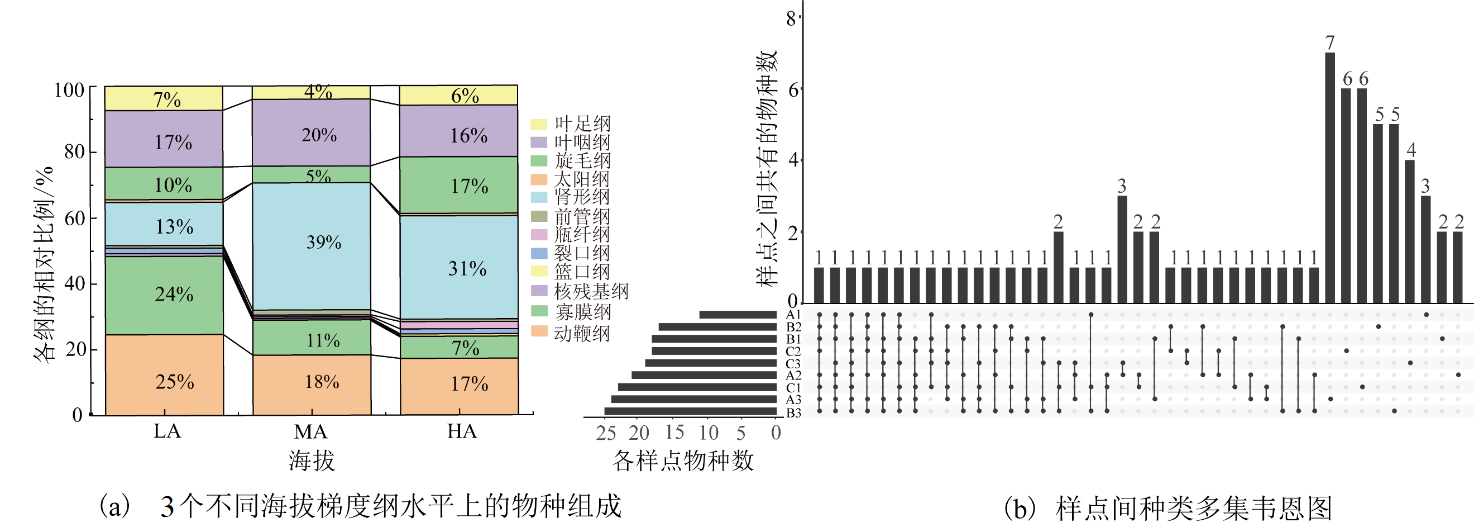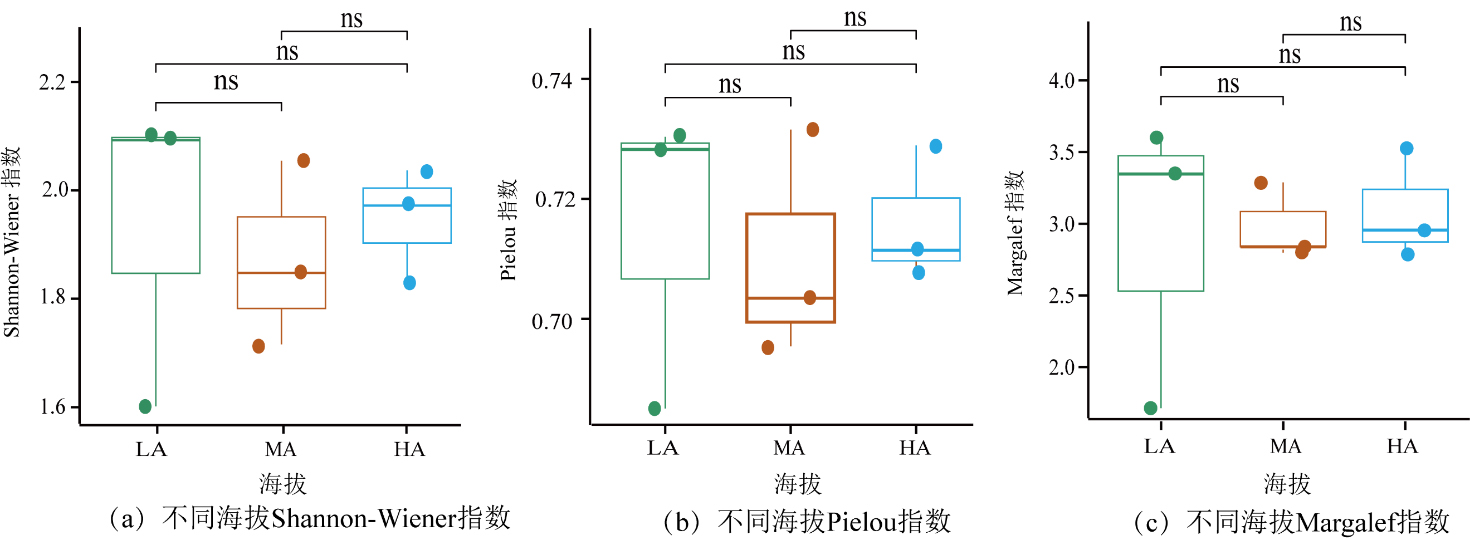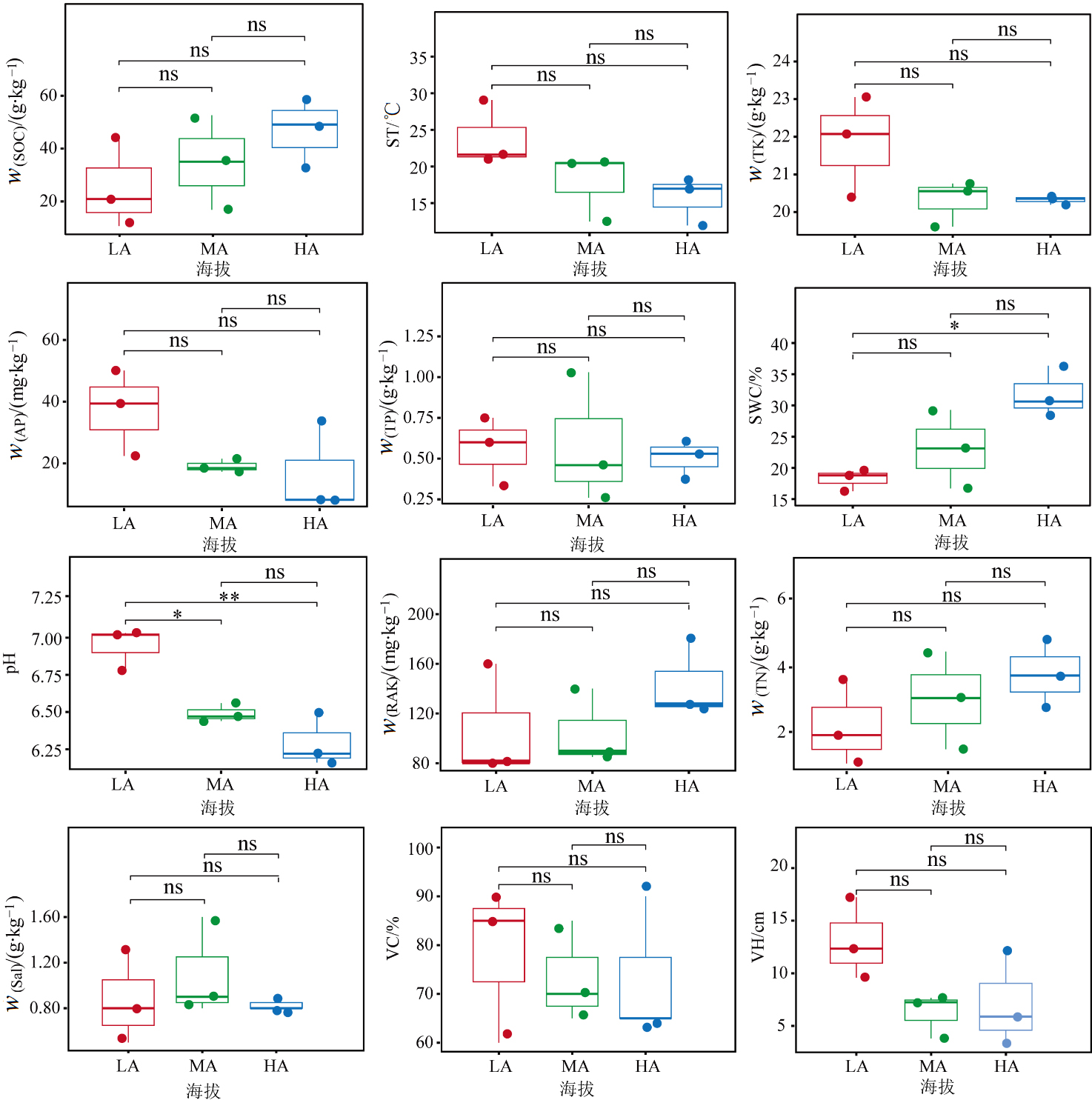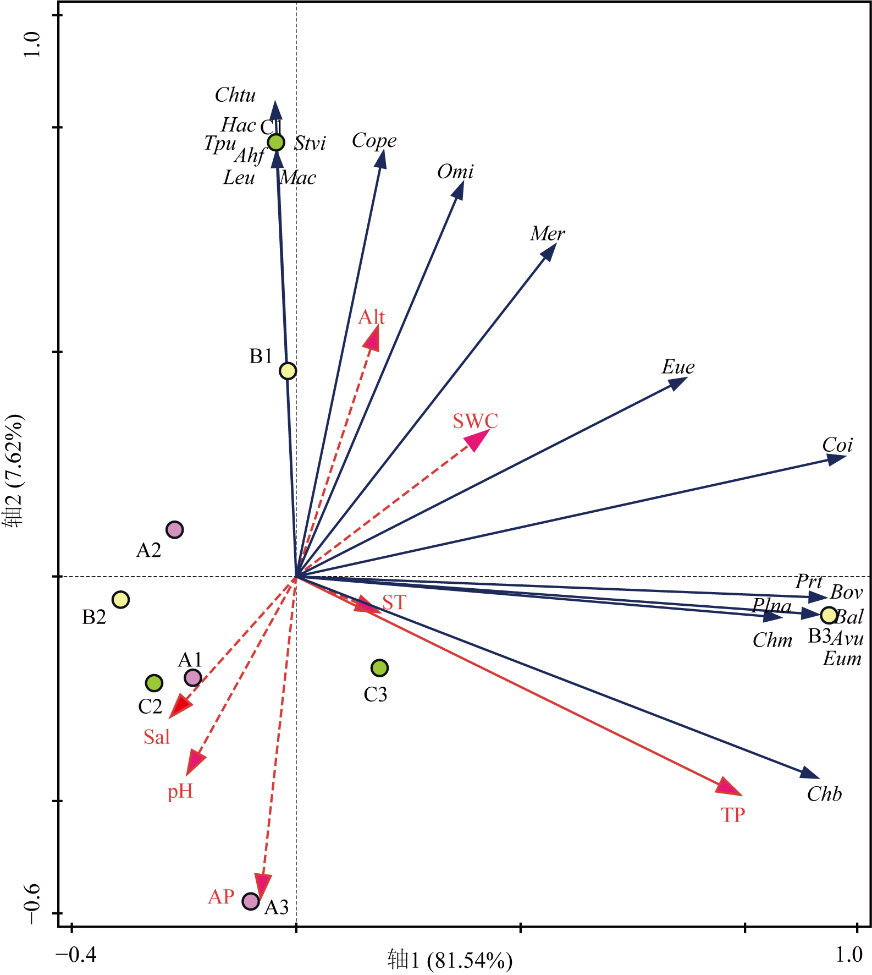生态环境学报 ›› 2024, Vol. 33 ›› Issue (4): 499-508.DOI: 10.16258/j.cnki.1674-5906.2024.04.001
• 研究论文【生态学】 •
下一篇
黄倩( ), 朱时应, 李天顺, 李明燕, 索南措, 普布*(
), 朱时应, 李天顺, 李明燕, 索南措, 普布*( )
)
收稿日期:2023-05-31
出版日期:2024-04-18
发布日期:2024-05-31
通讯作者:
*普布。E-mail: purbu@utibet.edu.cn作者简介:黄倩(1996年生),女,硕士研究生,主要从事土壤原生动物生态学方向的研究。E-mail: hq17878192280@163.com
基金资助:
HUANG Qian( ), ZHU Shiying, LI Tianshun, LI Mingyan, SUO Nancuo, PU Bu*(
), ZHU Shiying, LI Tianshun, LI Mingyan, SUO Nancuo, PU Bu*( )
)
Received:2023-05-31
Online:2024-04-18
Published:2024-05-31
摘要:
土壤原生动物是土壤中一类微型单细胞真核生物,是土壤的关键组成部分,对土壤环境质量动态变化具有重要的指示作用。为了解不同海拔土壤原生动物群落组成、多样性、分布格局及其与环境因子的耦合关系,于2021年7月根据西藏热振国家森林公园地理特征设置了3种不同海拔(低,LA;中,MA;高,HA)共9个样地,采用“非淹没培养法”、“活体观察法”和“Wilbert蛋白银法”对土壤原生动物进行培养和形态学鉴定。结果表明,研究区3种不同海拔共鉴定出土壤原生动物76种,隶属2门12纲23目32科46属,优势纲为动鞭纲(Zoomastigophorea),占总物种数的22.37%。其中,低海拔以动鞭纲为主,中高海拔以肾形纲(Colpodea)占据优势,这与肾形纲的生长方式为R-对策有关。Shannon-Wiener多样性指数、Pielou均匀度指数和Margalef丰富度指数在3种海拔段之间均无显著差异。土壤pH、含水量在低海拔和高海拔间存在差异。共发生网络分析显示,3个不同海拔土壤原生动物物种的共现网络节点间的关系主要为正相关。Mantel分析和冗余分析结果显示,总磷是影响土壤原生动物群落组成的主要驱动因子。该研究结果有助于了解西藏热振国家森林公园生态系统变化,为青藏高原生态环境保护和可持续发展提供基础数据支持。
中图分类号:
黄倩, 朱时应, 李天顺, 李明燕, 索南措, 普布. 西藏热振国家森林公园土壤原生动物群落沿海拔分布格局及其与环境因子的关联特征[J]. 生态环境学报, 2024, 33(4): 499-508.
HUANG Qian, ZHU Shiying, LI Tianshun, LI Mingyan, SUO Nancuo, PU Bu. Distribution Pattern of Soil Protozoa Community along Altitude and Its Correlation with Environmental Factors in Rating National Forest Park in Tibet, China[J]. Ecology and Environment, 2024, 33(4): 499-508.
| 样地 | 海拔/m | 东经 | 北纬 | 植被高度/cm | 植被盖度/% | 植被类型 |
|---|---|---|---|---|---|---|
| A1 | 4116 | 91°31′26.89″ | 30°18′50.49″ | 17.22 | 85 | 草本植物 |
| A2 | 4146 | 91°30′33.21″ | 30°18′24.91″ | 9.58 | 60 | 草本植物 |
| A3 | 4117 | 91°32′2.63″ | 30°19′19.722″ | 12.34 | 90 | 草本植物 |
| B1 | 4371 | 91°31′18.87″ | 30°19′11.31″ | 7.66 | 65 | 针叶灌丛 |
| B2 | 4352 | 91°30′34.81″ | 30°18′54.85″ | 3.82 | 70 | 针叶灌丛 |
| B3 | 4364 | 91°31′49.72″ | 30°19′32″ | 36.20 | 85 | 针叶灌丛 |
| C1 | 4576 | 91°31′8.87″ | 30°19′10.17″ | 3.30 | 90 | 高山草甸 |
| C2 | 4573 | 91°30′35″ | 30°19′3.83″ | 5.88 | 65 | 高山草甸 |
| C3 | 4567 | 91°31′49.61″ | 30°19′35.88″ | 12.20 | 65 | 高山草甸 |
表1 热振国家森林公园样地基本概况
Table 1 The basic situation of the sample plot in the Rating National Forest Park
| 样地 | 海拔/m | 东经 | 北纬 | 植被高度/cm | 植被盖度/% | 植被类型 |
|---|---|---|---|---|---|---|
| A1 | 4116 | 91°31′26.89″ | 30°18′50.49″ | 17.22 | 85 | 草本植物 |
| A2 | 4146 | 91°30′33.21″ | 30°18′24.91″ | 9.58 | 60 | 草本植物 |
| A3 | 4117 | 91°32′2.63″ | 30°19′19.722″ | 12.34 | 90 | 草本植物 |
| B1 | 4371 | 91°31′18.87″ | 30°19′11.31″ | 7.66 | 65 | 针叶灌丛 |
| B2 | 4352 | 91°30′34.81″ | 30°18′54.85″ | 3.82 | 70 | 针叶灌丛 |
| B3 | 4364 | 91°31′49.72″ | 30°19′32″ | 36.20 | 85 | 针叶灌丛 |
| C1 | 4576 | 91°31′8.87″ | 30°19′10.17″ | 3.30 | 90 | 高山草甸 |
| C2 | 4573 | 91°30′35″ | 30°19′3.83″ | 5.88 | 65 | 高山草甸 |
| C3 | 4567 | 91°31′49.61″ | 30°19′35.88″ | 12.20 | 65 | 高山草甸 |

图2 热振国家森林公园不同海拔土壤原生动物物种组成与分布
Figure 2 Species composition and distribution of soil protozoa at different elevations in the Rating National Forest Park

图3 热振国家森林公园不同海拔土壤原生动物多样性指数 图中数据为平均值±标准差(n=3);ns(p>0.05)表示无差异
Figure 3 Diversity index of soil protozoa at different elevations in the Rating National Forest Park
| 网络拓扑属性 | 不同海拔高度的网络拓扑参数 | ||
|---|---|---|---|
| 低海拔 (LA) | 中海拔 (MA) | 高海拔 (HA) | |
| 节点数 | 77 | 39 | 45 |
| 边数 | 213 | 231 | 303 |
| 平均加权度 | 7.17 | 7.74 | 13.73 |
| 平均度 | 5.53 | 11.85 | 13.47 |
| 模块化系数 | 0.87 | 1.22 | 0.95 |
| 平均聚类数 | 0.90 | 0.96 | 0.97 |
| 平均路径长度 | 1.90 | 1 | 1 |
| 图密度 | 0.07 | 0.31 | 0.31 |
| 正相关占比/% | 96.24 | 69.70 | 78.22 |
| 负相关占比/% | 3.76 | 30.30 | 21.78 |
表2 热振国家森林公园不同海拔土壤原生动物共现网络拓扑属性
Table 2 Topological properties of soil protozoa co-occurrence networks at different elevations in the Rating National Forest Park
| 网络拓扑属性 | 不同海拔高度的网络拓扑参数 | ||
|---|---|---|---|
| 低海拔 (LA) | 中海拔 (MA) | 高海拔 (HA) | |
| 节点数 | 77 | 39 | 45 |
| 边数 | 213 | 231 | 303 |
| 平均加权度 | 7.17 | 7.74 | 13.73 |
| 平均度 | 5.53 | 11.85 | 13.47 |
| 模块化系数 | 0.87 | 1.22 | 0.95 |
| 平均聚类数 | 0.90 | 0.96 | 0.97 |
| 平均路径长度 | 1.90 | 1 | 1 |
| 图密度 | 0.07 | 0.31 | 0.31 |
| 正相关占比/% | 96.24 | 69.70 | 78.22 |
| 负相关占比/% | 3.76 | 30.30 | 21.78 |

图5 热振国家森林公园不同海拔植被与土壤理化性质 SOC:有机碳;ST:土壤温度;TK:全钾;AP:有效磷;TP:总磷;SWC:土壤含水量;RAK:速效钾;TN:总氮;Sal:盐度;VC:植被盖度;VH:植被高度。图中数据为平均值±标准差(n=3);*(p<0.05)表示有差异,**(p<0.01)表示呈显著差异,ns(p>0.05)表示无差异
Figure 5 Physicochemical properties of soil at different elevations in the Fating National Forest Park

图6 热振国家森林公园不同海拔土壤原生动物群落与环境因子的Mantel分析 SOC:有机碳;ST:土壤温度;TK:全钾;AP:有效磷;TP:总磷;SWC:土壤含水量;RAK:速效钾;TN:总氮;Sal:盐度;VC:植被盖度;VH:植被高度 红色和蓝色分别表示两变量间的负相关和正相关关系,颜色越深表示关系越紧密;红色和绿色线条表示两变量间相关性的强弱。*、**和***分别表示p<0.05、p<0.01和p<0.001
Figure 6 Mantel analysis of soil protozoa community and environmental factors at different elevations in the Rating National Forest Park

图7 热振国家森林公园不同海拔土壤原生动物群落与环境因子的冗余分析(RDA) Chtu:膨胀斜管虫;Hac:太阳晶盘虫;Tpu:卑怯管叶虫;Ahf:弯凹表壳虫;Leu:大口薄咽虫;Stvi:绿急游虫;Mac:锐利楯纤虫;Cope:前突肾形虫;Omi:微盘盖虫;Mer:突额扭头; Eue:近亲游仆虫;Coi:膨胀肾形虫;Prt:圆柱前管虫;Bov:卵形波豆虫;Plna:鼻斜毛虫;Bal:阿氏波豆虫;Chm:凹扁拟斜管虫;Avu:普通表壳虫;Eum:黏游仆虫;Chb:巴维利亚斜管虫
Figure 7 Redundancy analysis (RDA) of soil protozoa community and environment factors at different elevations in the Rating National Forest Park
| [1] | ADL M S, GUPTA V S, 2006. Protists in soil ecology and forest nutrient cycling[J]. Canadian Journal of Forest Research, 36(7): 1805-1817. |
| [2] |
CHAFFRON S, REHRAUER H, PERNTHALER J, et al., 2010. A global network of coexisting microbes from environmental and whole-genome sequence data[J]. Genome Research, 20(7): 947-959.
DOI PMID |
| [3] | DENG Y, JIANG Y H, YANG Y, et al., 2012. Molecular ecological network analyses[J]. BioMed Central Bioinformatics, 13(1): 1-20. |
| [4] |
EKELUND F, RONN R, 1994. Notes on protozoa in agricultural soil with emphasis on heterotrophic flagellates and naked amoebae and their ecology[J]. Fems Microbiology Reviews, 15(4): 321-353.
PMID |
| [5] |
FIERER N, 2017. Embracing the unknown: disentangling the complexities of the soil microbiome[J]. Nature Reviews Microbiology, 15(10): 579-590.
DOI PMID |
| [6] | FOISSNER W, 1992. Estimating the species richness of soil protozoa using the “non-flooded petri dish method”[M]// Protocols in protozoology. Allen Press Lawrence, KS: B101-102. |
| [7] | GAO P, SONG B, XU R, et al., 2021. Structure and variation of root-associated bacterial communities of Cyperus rotundus L. in the contaminated soils around Pb/Zn mine sites[J]. Environmental Science and Pollution Research, 28: 58523-58535. |
| [8] | GEISEN S, BANDOW C, ROMBKE J, et al., 2015. Erratum to “Soil water availability strongly alters the community composition of soil protists”[J]. Pedobiologia, 58(1): 55. |
| [9] |
GEISEN S, MITCHELL E A, ADL S, et al., 2018. Soil protists: A fertile frontier in soil biology research[J]. Fems Microbiology Reviews, 42(3): 293-323.
DOI PMID |
| [10] |
LIU H, NING Y Z, YANG Y Q, et al., 2022. Use of ciliate communities for monitoring ecological restoration of grain for the green in north-western China[J]. Soil Ecology Letters, 4(3): 264-275.
DOI |
| [11] | LYNN D H, 2008. The ciliated protozoa: Characterization, classification, and guide to the literature[J]. Transactions of the American Microscopical Society, 98(3): 482-483. |
| [12] | MARGALEF R, 1968. Perspectives in ecological theory[J]. Chicago Series in Biology Show All Parts in This Series, 4(7): 220-221. |
| [13] | OLIVERIO A M, GEISEN S, DELGADO-BAQUERIZO M, et al., 2020. The global-scale distributions of soil protists and their contributions to belowground systems[J]. Science Advances, 6(4): eaax8787. |
| [14] | OPPERMAN M H, WOOD M, HARRIS P J, 1989. Changes in microbial populations following the application of cattle slurry to soil at two temperatures[J]. Soil Biology and Biochemistry, 21(2): 263-268. |
| [15] | PIELOU E C, 2011. An Introduction to Mathematical Ecology[J]. Bioscience, 24(2): 7-12. |
| [16] | SHANNON C E, 1948. A mathematical theory of communication[J]. The Bell System Technical Journal, 27(3): 379-423. |
| [17] |
TORSVIK V, OVERAS L, THINGSTAD T F, 2002. Prokaryotic diversity--magnitude, dynamics, and controlling factors[J]. Science, 296(5570): 1064-1066.
PMID |
| [18] | VERHOEVEN R, 2001. Response of soil microfauna to organic fertilisation in sandy virgin soils of coastal dunes[J]. Biology and Fertility of Soils, 6(34): 390-396. |
| [19] | WILBERT N, 1975. Eine verbesserte technik der protargolimpra gnation fur ciliaten[J]. Mikrokosmos, 64: 171-179. |
| [20] | XIAO E Z, NING Z P, XIAO T F, et al., 2021. Soil bacterial community functions and distribution after mining disturbance[J]. Soil Biology and Biochemistry, 157(1): 108-232. |
| [21] | XIONG W, JOUSSET A, GUO S, et al., 2018. Soil protist communities form a dynamic hub in the soil microbiome[J]. The International Society for Microbial Ecology Journal, 12(2): 634-638. |
| [22] | XUE P P, MINASNY B, MCBRATNEY A B, 2022. Land-use affects soil microbial co-occurrence networks and their putative functions[J]. Applied Soil Ecology, 169(1): 104184. |
| [23] | 陈德来, 普布, 巴桑, 等, 2014. 西藏拉鲁湿地夏季土壤线虫群落特征[J]. 动物学杂志, 49(5): 744-753. |
| CHEN D L, PU B, BA S, et al., 2014. Characterization of nematode communities in Lhalu Wetlands during the summer[J]. Chinese Journal of Zoology, 49(5): 744-753. | |
| [24] | 次仁, 次仁欧珠, 郑毅, 等, 2017. 热振国家森林公园秋季鸟类物种多样性研究[J]. 高原科学研究, 1(1): 17-24. |
| CI R, CI R O Z, ZHENG Y, et al., 2017. Preliminary report on species diversity of birds in rating national forest park during the autumn season[J]. Plateau Science Research, 1(1): 17-24. | |
| [25] | 旦增央, 杨鄢萍, 张海滨, 等, 2019. 热振国家森林公园木本植物组成结构及区系研究[J]. 南方农业, 13(21): 161-162. |
| DAN Z Y, YANG Y P, ZHANG H B, et al., 2019. Study on composition and flora of woody plants in Rating national forest park[J]. South China Agriculture, 13(21): 161-162. | |
| [26] | 冯伟松, 范小鹏, 沈韫芬, 等, 2003. 武夷山九曲溪水体营养水平与原生动物群落变化相互关系研究[J]. 水生生物学报, 27(6): 580-583. |
| FENG W S, FAN X P, SHEN Y F, et al., 2003. Study on the relationship between the protozoan community structure and the nutrition level of Jiuquxi brook in Wuyi Mountain[J]. Acta Hydrobiologica Sinica, 27(6): 580-583. | |
| [27] | 高云超, 朱文珊, 陈文新, 2000. 土壤原生动物群落及其生态功能[J]. 生态学杂志, 19(1): 59-65. |
| GAO Y C, ZHU W S, CHEN W X, 2000. Structure of the protozoan community in soil and its ecological functions[J]. Chinese Journal of Ecology, 19(1): 59-65. | |
| [28] |
黄伟佳, 刘春, 刘岳, 等, 2023. 南岭山地不同海拔土壤生态化学计量特征及影响因素[J]. 生态环境学报, 32(1): 80-89.
DOI |
| HUANG W J, LIU C, LIU Y, et al., 2023. Soil ecological stoichiometyr and its influencing factors at different elevations in Nanling Mountains[J]. Ecology and Environmental Sciences, 32(1): 80-89. | |
| [29] | 刘旻霞, 李全弟, 蒋晓轩, 等, 2019. 兰州市北山不同林地春夏季土壤纤毛虫群落特征[J]. 生态学报, 40(12): 3955-3967. |
| LIU M X, LI Q D, JIANG X X, et al., 2020. Characteristics of soil ciliate communities in spring and summer in different woodlands of Beishan, Lanzhou city[J]. Acta Ecologica Sinica, 40(12): 3955-3967. | |
| [30] | 莫申国, 张百平, 程维明, 等, 2004. 青藏高原的主要环境效应[J]. 地理科学进展, 23(2): 88-96. |
|
MO S G, ZHANG B P, CHENG W M, et al., 2004. Major environmental effects of the Tibetan Plateau[J]. Progress in Geography, 23(2): 88-96.
DOI |
|
| [31] | 宁应之, 沈韫芬, 1998. 中国典型地带土壤原生动物: II.生态学研究[J]. 动物学报, 44(3): 271-276. |
| NING Y Z, SHEN Y F, 1998. Soil protozoa in typical zones of China: Ⅱ Ecological study[J]. Acta Zoologica Sinica, 44(3): 271-276. | |
| [32] | 宁应之, 沈韫芬, 1999. 中国典型地带土壤原生动物群落结构及其特征[J]. 西北师范大学学报(自然科学版), 35(2): 50-54. |
| NING Y Z, SHEN Y F, 1999. Community structure and characteristics of soil protozoa in typical areas of China[J]. Journal of Northwest Normal University (Natural Science), 35(2): 50-54. | |
| [33] |
宁应之, 王婷婷, 武维宁, 等, 2017. 甘南高寒草甸土壤纤毛虫对磷酸氢二铵添加的响应[J]. 应用生态学报, 28(5): 1668-1678.
DOI |
| NING Y Z, WANG T T, WU W N, et al., 2017. Response of soil ciliate to diammonium phosphate addition alpine meadow of southern Gansu, Northwest China[J]. Chinese Journal of Applied Ecology, 28(5): 1668-1678. | |
| [34] |
宁应之, 徐富荣, 王婷婷, 2020. 庆阳市庆城县退耕还林区土壤纤毛虫群落特征[J]. 生态环境学报, 29(3): 506-515.
DOI |
| NING Y Z, XU F R, WANG T T, 2020. Community characteristics of soil ciliates in forestlands converted from cultivated lands in Qingcheng county, Qingyang city[J]. Ecology and Environmental Sciences, 29(3): 506-515. | |
| [35] |
任倩茹, 毛晓雅, 齐晓君, 等, 2023. 芦芽山华北落叶松林不同深度土壤原生动物群落分布格局及驱动机制[J]. 应用生态学报, 34(5): 1395-1403.
DOI |
| REN Q R, MAO X Y, QI X J, et al., 2023. Distribution patterns and driving mechanism of soil protozoan community at the different depths of Larix principis-chinensis forest in the Luya Mountain, China[J]. Chinese Journal of Applied Ecology, 34(5): 1395-1403. | |
| [36] | 宋微波, 徐奎栋, 1994. 纤毛虫原生动物形态学研究的常用方法[J]. 海洋科学, 18(6): 6-9. |
| SONG W B, XUE K D, 1994. Common methods for morphological studies of ciliated protozoa[J]. Marine Sciences, 18(6): 6-9. | |
| [37] |
孙鸿烈, 郑度, 姚檀栋, 等, 2012. 青藏高原国家生态安全屏障保护与建设[J]. 地理学报, 67(1): 3-12.
DOI |
|
SUN H L, ZHENG D, YAO C D, et al., 2012. Protection and construction of the national ecological security shelter zone on Tibetan Plateau[J]. Acta Geographica Sinica, 67(1): 3-12.
DOI |
|
| [38] | 王超, 徐润林, 2017. 鼎湖山不同森林类型土壤纤毛虫群落比较研究[J]. 土壤, 49(4): 725-732. |
| WANG C, XU R L, 2017. Comparative study on soil ciliates community structures under different vegetation types in Dinghu Mountain[J]. Soils, 49(4): 725-732. | |
| [39] | 王壮壮, 李天顺, 朱时应, 等, 2022. 热振森林大型土壤动物群落特征及其影响因素[J]. 中国环境科学, 42(7): 3392-3402. |
| WANG Z Z, LI T S, ZHU S Y, et al., 2022. Community characteristics of soil macrofauna and its influencing factors at Rating Forest[J]. China Environmental Science, 42(7): 3392-3402. | |
| [40] | 吴聪, 刘海平, 谢佳燕, 等, 2022. 雅鲁藏布江流域原生动物群落结构及其与环境因子的关系[J]. 武汉大学学报: 理学版, 68(6): 621-634. |
| WU C, LIU H P, XIE J Y, et al., 2022. Community structure of protozoan and its relation to environmental factors in the Yarlung Zangbo river basin[J]. Journal of Wuhan University (Natural Science Edition), 68(6): 621-634. | |
| [41] | 杨清, 张鹏, 安瑞志, 等, 2022. 拉萨河中下游纤毛虫群落时空分布模式及其驱动机制[J]. 生物多样性, 30(6): 136-150. |
| YANG Q, ZHANG P, AN R Z, et al., 2022. Spatial and temporal distribution patterns and driving mechanisms of ciliate communities in the midstream and downstream reaches of the Lhasa River[J]. Biodiversity Science, 30(6): 136-150. | |
| [42] | 杨笑笑, 刘信宝, 陈震, 等, 2022. 土壤盐度影响甜高粱生长发育及脱盐因素分解的研究[J]. 中国草地学报, 44(5): 73-81. |
| YANG X X, LIU X B, CHEN Z, et al., 2022. Effects of soil salinity on growth of sweet sorghum and decomposition of desalination factors[J]. Chinese Journal of Grassland, 44(5): 73-81. | |
| [43] | 殷秀琴, 宋博, 邱丽丽, 2007. 红松阔叶混交林凋落物-土壤动物-土壤系统中N, P, K的动态特征[J]. 生态学报, 27(1): 128-134. |
| YIN X Q, SONG B, QIU L L, 2007. Dynamic characteristics of N, P, K in the iteresoil fauna soil system of mixed Pinus koraiensis and broad-leaved forest[J]. Acta Ecologica Sinica, 27(1): 128-134. | |
| [44] | 张剑, 宿力, 王利平, 等, 2019. 植被盖度对土壤碳、氮、磷生态化学计量比的影响——以敦煌阳关湿地为例[J]. 生态学报, 39(2): 580-589. |
| ZHANG J, SU L, WANG L P, et al., 2019. The effect of vegetation cover on ecological stoichiometric ratios of soil carbon, nitrogen and phosphorus: A case study of the Dunhuang Yangguan wetland[J]. Acta Ecologica Sinica, 39(2): 580-589. | |
| [45] | 张鹏, 刘洋, 安瑞志, 等, 2022. 西藏拉萨河中下游原生动物优势种时空生态位[J]. 林业科学, 58(1): 78-88. |
| ZHANG P, LIU Y, AN R Z, et al., 2022. Spatio-Temporal niche of dominant protozoa species in the midstream and downstream of Lhasa River, Tibet, China[J]. Scientia Silvae Sinicae, 58(1): 78-88. | |
| [46] | 周凤霞, 陈剑虹, 2011. 淡水微型生物与底栖动物图谱[M]. 北京: 化学工业出版社: 201-326. |
| ZHOU F X, CHEN J H, 2011. Atlas of freshwater microbiota and benthos[M]. Beijing: Chemical Industry Press:201-326. | |
| [47] | 张雪萍, 李春艳, 殷秀琴, 等, 1999. 不同使用方式林地的土壤动物与土壤营养元素的关系[J]. 应用与环境生物学报, 5(1): 27-32. |
| ZHANG X P, LI C Y, YIN X Q, et al., 1999. Relation between soil animals and nutrients in the differently used forest lands[J]. Chinese Journal of Applied and Environmental Biology, 5(1): 27-32. | |
| [48] | 中国科学院青藏高原综合科学考察队编写, 1983. 西藏水生无脊椎动物[M]. 北京: 科学出版社:291-344. |
| Tibetan Plateau comprehensive research team, Chinese Academy of Sciences, 1983. Aquatic Invertebrates of Tibet[M]. Beijing: Science Press:291-344. | |
| [49] | 朱时应, 王壮壮, 黄倩, 等, 2022. 西藏年楚河流域湿地土壤纤毛虫群落特征[J]. 生态学报, 42(22): 9005-9016. |
| ZHU S Y, WANG Z Z, HUANG Q, et al., 2022. Characteristics of soil ciliate community in wetland of the Nianchu River Basin, Tibet, China[J]. Acta Ecologica Sinica, 42(22): 9005-9016. |
| [1] | 翟涌光, 王晓妮, 郝蕾, 戚文超, 王雅崧, 耿佳玉, 兰穹穹, 王志国. 2001-2020年内蒙古净生态系统生产力格局多时间尺度分析[J]. 生态环境学报, 2024, 33(2): 167-179. |
| [2] | 马媛, 田路露, 吕杰, 柳沛, 张旭, 李二阳, 张清航. 天山北坡雪岭云杉森林土壤微生物群落及影响因素研究[J]. 生态环境学报, 2024, 33(1): 1-11. |
| [3] | 姜永伟, 丁振军, 袁俊斌, 张峥, 李杨, 问青春, 王业耀, 金小伟. 辽宁省主要河流底栖动物群落结构及水质评价研究[J]. 生态环境学报, 2023, 32(5): 969-979. |
| [4] | 寇祝, 卿纯, 袁昌果, 李平. 西藏东北部热泉水中硫氧化菌的多样性及分布特征[J]. 生态环境学报, 2023, 32(5): 989-1000. |
| [5] | 杨春亮, 刘旻霞, 王千月, 苗乐乐, 肖音迪, 王敏. 单户与联户放牧经营下草玉梅与嵩草种群空间格局及其关联性[J]. 生态环境学报, 2023, 32(4): 651-659. |
| [6] | 李善家, 王兴敏, 刘海锋, 孙梦格, 雷雨昕. 河西走廊荒漠植物多样性及其对环境因子的响应[J]. 生态环境学报, 2023, 32(3): 429-438. |
| [7] | 阳涅, 孙晓旭, 孔天乐, 孙蔚旻, 陈泉源, 高品. 微生物群落对河流底泥中锑含量变化的响应[J]. 生态环境学报, 2023, 32(3): 609-618. |
| [8] | 宋志斌, 周佳诚, 谭路, 唐涛. 高原河流着生藻类群落沿海拔梯度的变化特征--以西藏黑曲、雪曲为例[J]. 生态环境学报, 2023, 32(2): 274-282. |
| [9] | 周佳诚, 宋志斌, 苗芃, 谭路, 唐涛. 柳江不同河网位置大型底栖动物群落特征及其影响因子差异比较研究[J]. 生态环境学报, 2023, 32(10): 1794-1801. |
| [10] | 向兴, 满百膺, 张俊忠, 罗洋, 毛小涛, 张超, 孙丙华, 王希. 黄山土壤细菌群落及氮循环功能群的垂向分布格局[J]. 生态环境学报, 2023, 32(1): 56-69. |
| [11] | 李萍, 白小明, 陈鑫, 李娟霞, 冉福, 陈辉, 杨小妮, 康瑞卿. 白三叶入侵对禾本科草坪土壤特性和植物群落的影响[J]. 生态环境学报, 2023, 32(1): 70-79. |
| [12] | 姜倪皓, 张世浩, 张诗函. 哀牢山紫茎泽兰入侵群落主要物种种间联结及环境解释[J]. 生态环境学报, 2022, 31(7): 1370-1382. |
| [13] | 朱立安, 张会化, 程炯, 李婷, 林梓, 李俊杰. 珠江三角洲林业用地土壤重金属潜在生态风险格局分析[J]. 生态环境学报, 2022, 31(6): 1253-1262. |
| [14] | 温智峰, 魏识广, 李林, 叶万辉, 练琚愉. 南亚热带常绿阔叶林植物不同分类水平上的空间分布格局及空间关联[J]. 生态环境学报, 2022, 31(3): 440-450. |
| [15] | 夏开, 邓鹏飞, 马锐豪, 王斐, 温正宇, 徐小牛. 马尾松次生林转换为湿地松和杉木林对土壤细菌群落结构和多样性的影响[J]. 生态环境学报, 2022, 31(3): 460-469. |
| 阅读次数 | ||||||
|
全文 |
|
|||||
|
摘要 |
|
|||||
